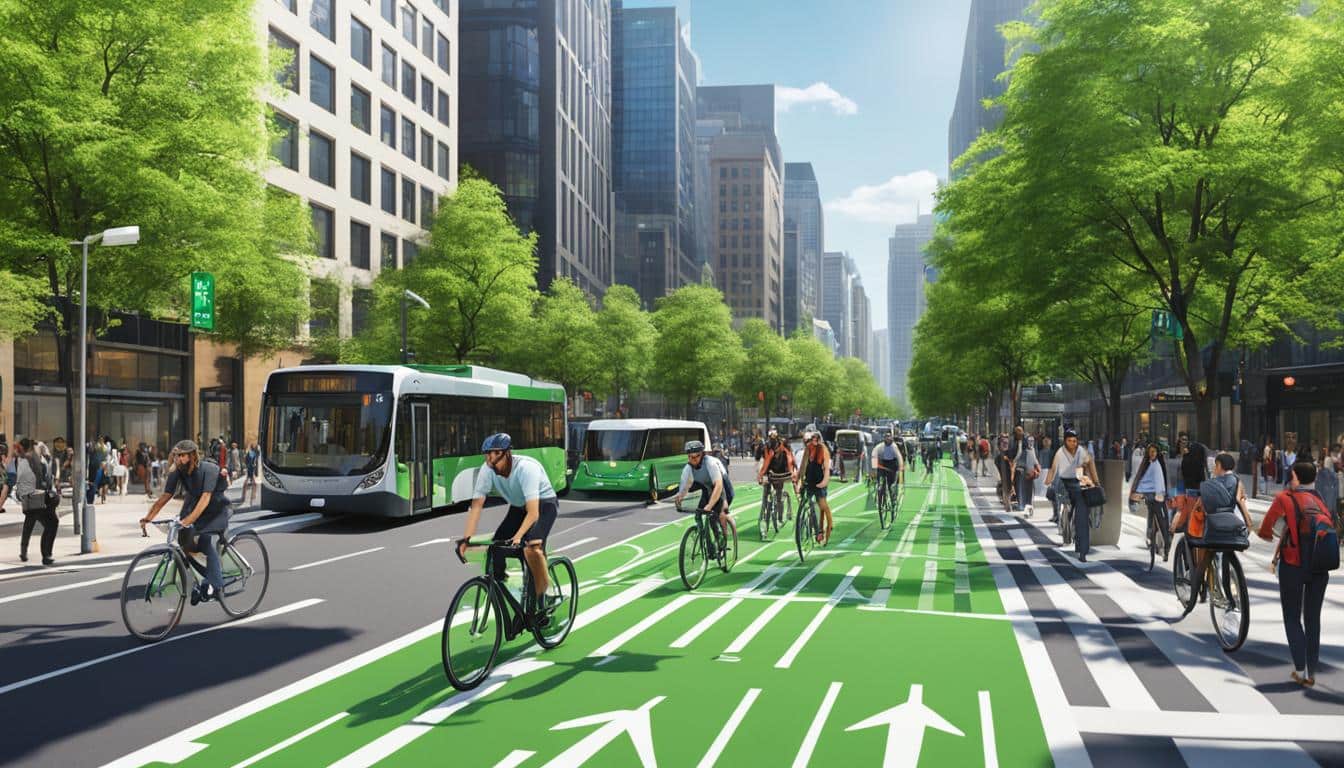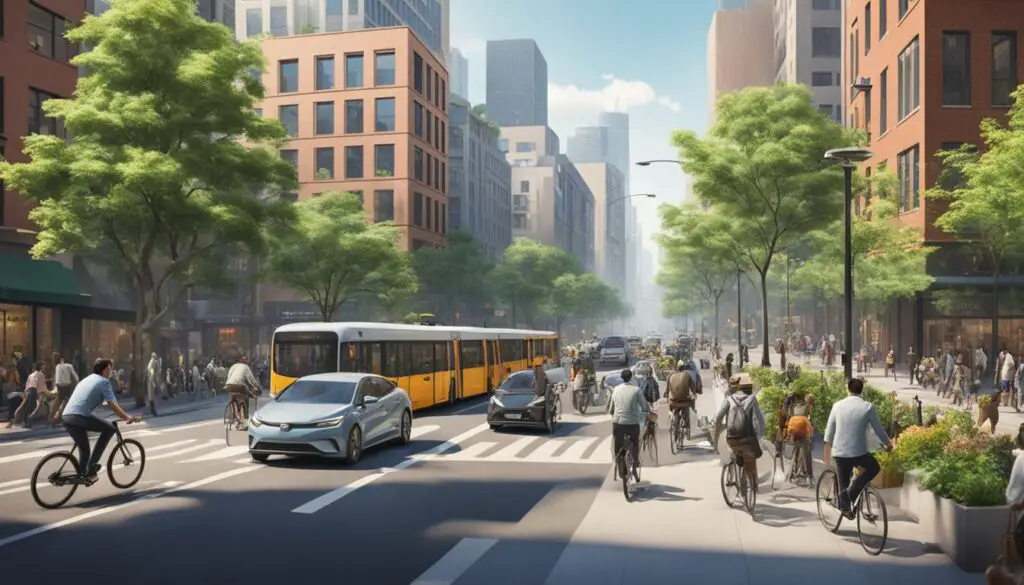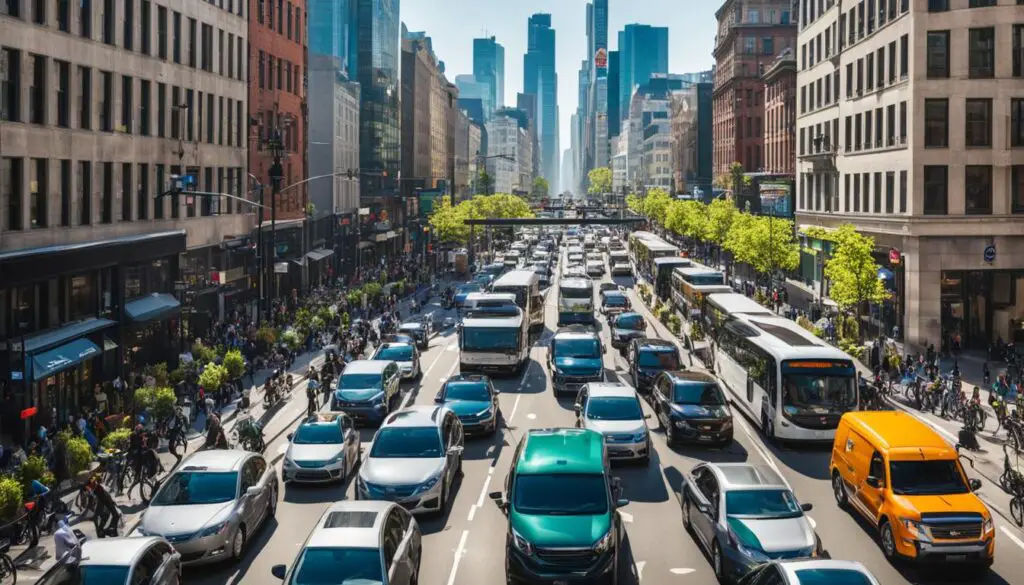
Sustainable Urban Transportation: Solutions for a Greener Tomorrow
Greetings, readers! I am excited to delve into the topic of sustainable transportation solutions, particularly in urban areas, and the importance of creating an eco-friendly cityscape. As our world continues to grapple with climate change and environmental challenges, it is crucial to explore innovative ways to reduce our carbon footprint and create more sustainable urban environments.
Urban areas play a significant role in the global carbon emissions and pollution levels. The transportation sector, in particular, is a major contributor to greenhouse gas emissions and air pollution. However, by adopting sustainable transportation options, we can pave the way for a cleaner, greener future.
In this article, I will discuss the importance of sustainable transportation in urban areas, highlight some innovative solutions that can be implemented, explore the benefits of sustainable urban transportation, and address the challenges and solutions involved in its implementation.
Key Takeaways:
- Urban areas face significant environmental challenges, and sustainable transportation is a key solution.
- Implementing electric vehicles, public transportation, cycling, and walking can reduce air pollution and traffic congestion.
- Sustainable transportation options promote healthier lifestyles and create livable and sustainable urban environments.
- Benefits of sustainable urban transportation include reducing air pollution, improving public health, and enhancing the quality of life in cities.
- Challenges in implementing sustainable transportation can be overcome through public-private partnerships, government incentives, and community engagement.
I hope you are as eager as I am to delve into the world of sustainable transportation solutions, their impact on urban areas, and the potential for creating an eco-friendly cityscape. Let’s explore together how these solutions can shape a greener tomorrow for all.
The Importance of Sustainable Transportation in Urban Areas
Sustainable transportation plays a crucial role in reducing carbon emissions and combating climate change, particularly in urban areas. By embracing sustainable transportation options, such as electric vehicles, public transportation, cycling, and walking, cities can significantly reduce air pollution and alleviate traffic congestion. These eco-friendly alternatives not only minimize the environmental impact but also contribute to creating healthier lifestyles and more livable urban environments.
One of the key advantages of sustainable transportation in urban areas is the reduction of air pollution. Automobiles are a major source of greenhouse gas emissions and contribute to poor air quality. By promoting sustainable transportation options, cities can improve the air we breathe and mitigate the adverse effects on public health.
Additionally, sustainable transportation helps tackle traffic congestion, a common problem in many urban areas. The use of public transportation, cycling, and walking provides alternatives to private vehicles, reducing the number of cars on the road and alleviating traffic congestion. Not only does this result in smoother traffic flow, but it also saves time and enhances the overall quality of life for urban residents.
Furthermore, sustainable transportation options promote healthier lifestyles by encouraging physical activity. Incorporating walking or cycling into daily commutes not only reduces carbon emissions but also improves individual fitness levels. This leads to better overall health outcomes and a reduced risk of chronic diseases associated with sedentary lifestyles.
“The move towards sustainable transportation in urban areas is essential for creating greener and more livable cities. By embracing eco-friendly alternatives, we can minimize the environmental impact, improve air quality, and enhance the overall well-being of urban residents.”
In summary, the importance of sustainable transportation in urban areas cannot be overstated. By adopting eco-friendly alternatives to traditional modes of transportation, cities can make a significant positive impact on the environment, public health, and the overall quality of life for their residents. The transition to sustainable transportation is a vital step towards creating greener, more sustainable urban environments for current and future generations.
Innovative Sustainable Transportation Solutions
When it comes to sustainable transportation solutions in urban areas, innovation plays a crucial role. By implementing forward-thinking strategies, cities can create a greener and more efficient transportation system for their residents. Here are some innovative solutions that can contribute to a sustainable urban transportation ecosystem:
1. Electric Vehicle Infrastructure
The development of electric vehicle infrastructure, such as charging stations, is a key component of sustainable transportation. By providing accessible and convenient charging options, cities can encourage the adoption of electric vehicles, reducing dependence on fossil fuels and lowering carbon emissions.
2. Promotion of Electric Vehicle Adoption
In addition to infrastructure development, promoting electric vehicle adoption is essential for sustainable transportation in urban areas. This can be achieved through various incentives such as tax credits, rebates, and subsidies, making electric vehicles more affordable and attractive to potential buyers.
3. Expansion of Public Transportation Systems
An expanded and well-connected public transportation network is vital for reducing the number of private vehicles on the roads. By offering reliable and efficient public transportation options, cities can encourage residents to rely less on personal cars, leading to reduced traffic congestion and improved air quality.
4. Improvement of Cycling and Pedestrian Infrastructure
Promoting cycling and walking as viable modes of transportation requires the development of safe and well-maintained infrastructure. Dedicated bike lanes, pedestrian-friendly sidewalks, and integrated systems that prioritize non-motorized transportation can encourage more people to choose sustainable options for their daily commute.
5. Car-sharing and Ride-sharing Services
Car-sharing and ride-sharing services provide flexible transportation options while promoting the efficient use of vehicles. By reducing the number of cars on the road, these services contribute to a reduction in traffic congestion and greenhouse gas emissions in urban areas.
Implementing these innovative solutions in urban areas can pave the way for a more sustainable future. By embracing new technologies and promoting eco-friendly transportation alternatives, cities can create a cleaner, healthier, and more livable environment for their residents.
Benefits of Sustainable Urban Transportation
Sustainable urban transportation presents a multitude of benefits that contribute to a greener and more eco-friendly future. By embracing sustainable transportation options, cities can achieve significant positive impacts on the environment, public health, and overall quality of life in urban areas.

One of the primary advantages of sustainable urban transportation is the reduction of air pollution and greenhouse gas emissions. By promoting modes of transportation that have lower carbon footprints, such as electric vehicles, public transportation, cycling, and walking, cities can mitigate the harmful effects of vehicle emissions on air quality and climate change. This, in turn, leads to improved environmental conditions and healthier ecosystems.
Moreover, sustainable transportation options enhance public health by encouraging physical activity. Walking and cycling, for instance, provide opportunities for exercise, reducing sedentary lifestyles and promoting cardiovascular fitness. By prioritizing pedestrian-friendly infrastructures, cities create safer and more inviting environments for active transportation, benefiting the well-being of residents.
“Sustainable urban transportation not only reduces air pollution and congestion but also improves public health and enhances the overall well-being of urban dwellers.”
Another significant benefit of sustainable transportation is the reduction of traffic congestion. By adopting efficient and shared modes of transportation, such as carpooling and ride-sharing services, cities can alleviate traffic volumes on roadways. This leads to improved traffic flow, reduced travel times, and decreased stress levels for commuters.
Finally, sustainable transportation options contribute to the creation of a more inclusive and equitable cityscape. By providing affordable and accessible transportation choices for all residents, regardless of income or physical abilities, cities ensure that everyone has equal opportunities to travel, work, and engage within the urban environment.
| Benefits of Sustainable Urban Transportation |
|---|
| Reduces air pollution and greenhouse gas emissions |
| Promotes physical activity and improves public health |
| Reduces traffic congestion |
| Enhances the overall quality of life in urban areas |
| Creates a more inclusive and equitable cityscape |
Challenges and Solutions for Implementing Sustainable Transportation
Implementing sustainable transportation in urban areas is not without its challenges. Overcoming these obstacles is crucial to ensure the successful adoption of eco-friendly transportation solutions.
Funding for Infrastructure Development
One of the main challenges in implementing sustainable transportation is the limited funding available for infrastructure development. Building and maintaining infrastructure for electric vehicles, cycling lanes, and pedestrian walkways requires significant investment. Without adequate funding, it becomes difficult to create the necessary infrastructure to support sustainable transportation options.
Resistance to Change
Resistance to change is another common challenge faced when promoting sustainable transportation. Many people are resistant to transitioning from traditional modes of transportation to more sustainable alternatives. This resistance can be due to a lack of awareness, convenience, or emotional attachment to their current modes of transport. Overcoming this resistance requires effective education and awareness campaigns, highlighting the benefits and encouraging behavior change.
Coordination Among Stakeholders
The implementation of sustainable transportation solutions involves multiple stakeholders, including government agencies, transportation authorities, urban planners, and private sector organizations. Coordinating efforts and aligning interests among these stakeholders can be challenging. It requires effective communication, collaboration, and leadership to ensure a unified approach towards sustainable transportation goals.
However, despite these challenges, there are feasible solutions that can help overcome them:
“Public-private partnerships, government incentives, and community engagement can play a crucial role in overcoming the challenges of implementing sustainable transportation solutions.”
Public-private partnerships can leverage the resources and expertise of both sectors to develop and implement sustainable transportation projects. Governments can incentivize the adoption of eco-friendly transportation options through subsidies, tax benefits, and grants. Community engagement programs can raise awareness, provide education, and foster a sense of ownership and responsibility among residents.
| Challenges | Solutions |
|---|---|
| Limited funding for infrastructure development | Public-private partnerships and government funding |
| Resistance to change | Educational campaigns and incentives |
| Coordination among stakeholders | Effective communication and collaboration |

Conclusion
In conclusion, the implementation of sustainable transportation solutions is crucial for creating a greener and more eco-friendly future in urban areas. By adopting innovative strategies and comprehensive approaches, we have the power to make a significant positive impact on our environment. Through the reduction of carbon emissions and the improvement of air quality, we can contribute to healthier and more livable cities.
Collaboration between governments, businesses, and individuals is essential in prioritizing and advancing sustainable transportation solutions. By working together, we can overcome the challenges faced and bring about meaningful change. Governments can provide incentives and policies that encourage the adoption of eco-friendly transportation options. Businesses can invest in research and development to create innovative technologies and infrastructure. Individuals can make conscious choices to utilize sustainable transportation methods.
By focusing attention on sustainable transportation solutions in urban areas, we are not only addressing immediate environmental concerns but also paving the way for a better future for generations to come. With determination and commitment, we can create a more sustainable and eco-friendly world – one where urban areas are characterized by clean air, reduced congestion, and enhanced quality of life for residents.
FAQ
Why is sustainable transportation important in urban areas?
Sustainable transportation is crucial in urban areas to reduce carbon emissions, combat climate change, and improve air quality. It also promotes healthier lifestyles and creates more livable and sustainable cities.
What are some innovative sustainable transportation solutions for urban areas?
Some innovative sustainable transportation solutions include the development of electric vehicle infrastructure, such as charging stations, the expansion and improvement of public transportation systems, the enhancement of cycling and pedestrian infrastructure, and the implementation of car-sharing and ride-sharing services.
What are the benefits of sustainable urban transportation?
Sustainable urban transportation offers numerous benefits, including the reduction of air pollution and greenhouse gas emissions, improvement of public health through physical activity, alleviation of traffic congestion, and enhancement of the overall quality of life in urban areas.
What are the challenges in implementing sustainable transportation in urban areas?
Challenges in implementing sustainable transportation in urban areas include limited funding for infrastructure development, resistance to change, and the need for coordination among various stakeholders. However, public-private partnerships, government incentives, and community engagement can help overcome these challenges.
How can sustainable transportation solutions be prioritized and accelerated?
Governments, businesses, and individuals should collaborate and prioritize sustainable transportation solutions by investing in infrastructure development, providing incentives for eco-friendly transportation choices, and actively participating in community engagement initiatives.
